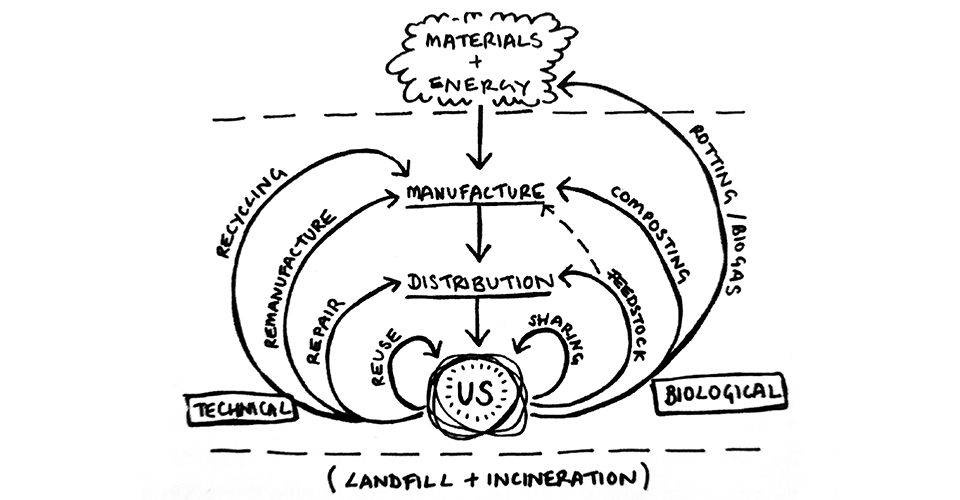For years, the world’s industries have been dominated by a linear, degenerative and destructive economy. We took the Earth’s materials, made them into things we needed or wanted, used them for a while, and then threw them away – the relationship between resources and products existing in a one-way flow of traffic, designed to extract the most value and with a focus on single use.
We now face a climate crisis of staggering proportions and it’s become clear that our toll on the environment far exceeds what the planet can withstand. The team at Earth Overshoot Day has stated that, by 28 July, humanity’s demand for ecological resources and services will have already exceeded what the Earth can regenerate in 2022. This overspending of our natural stocks without a clear recovery plan is leading us toward economic and environmental bankruptcy. But, by rethinking our products and supply chains, the circular economy offers businesses to turn this challenge into an opportunity.
Looping into the circular economy
The circular economy provides a framework that can play a part in solving our climate crisis.
For the Ellen MacArthur Foundation, the circular economy is defined as “a systems solution framework that tackles global challenges like climate change, biodiversity loss, waste, and pollution.”
In her recent book, Welcome To The Circular Economy: The Next Step In Sustainable Living, design thinker Claire Potter elaborates further, defining the circular economy as a “system in which materials and resources loop around, again and again, without loss of quality, though sometimes in different forms. Everything is used, nothing is wasted, and our bin at the bottom is pretty much redundant, as we have found a use for everything we make and use.”
Potter explains that although this can at first seem idyllic and idealistic, if anything it is inspired by the reality that nature doesn’t do waste and that we are the only species on the planet that creates it.
It’s about redesigning the way our businesses work and transforming our economy from its current ‘take-make-waste’ system into one that eliminates waste, where products last longer, and where would-be waste is transformed into materials suitable for new uses.

Claire Potter, Welcome To The Circular Economy
Over the last few years, we’ve seen designers and consumers embracing these ideas and introducing sustainable design principles that can be seen across a range of industries. For example, we see waste nylon fishing nets regenerated into ECONYL® yarn and then repurposed for a range of uses, from swimwear, to high fashion and accessories, and within our own carpet tiles.
In addition, groups like NextWave Plastics are bringing diverse brands such as Interface, Dell, IKEA, HP and MillerKnoll together to tackle several forms of ocean-bound plastic. This keeps waste plastics in our economy and out of the ocean.
We have also seen moves at a national and EU level to standardise designs and parts to ensure compatibility and reduce waste via obsolescence.
The five Rs
For many of us, recycling would seem the most logical place to start when it comes to introducing the principles of a circular economy. In fact, in an ideal system recycling should be considered further down the list of options.
According to the five Rs – a common circular framework – four actions should be taken prior to recycling, wherever possible:
- Refuse waste by rejecting inefficient products and unnecessary packaging, and make smarter decisions when it comes to materials and processes.
- Reduce the use of wasteful and non-recyclable products.
- Reuse as many materials and products as possible. Reject ‘throwaway’ culture and single-use design.
- Repurpose any item that can’t be refused, reduced, or reused. Find new uses for old items and upcycle where possible.
- And then Recycle. Once the previous ‘Rs’ have been exhausted, recycling is the most environmentally friendly method of waste disposal.
By considering these five Rs, designers can move beyond simply rethinking individual products and begin to consider the entire system that surrounds them.
Leading by example
A circular economy isn’t just good for the planet, it also makes long-term economic sense for entire industries and individual businesses alike.
At Interface, we’ve built sustainability into our business model for over 25 years and are committed to working in a way that’s better for the planet and its people.
That includes introducing schemes that give our products a second life, like ReEntry, which puts used carpet tiles to good use by making sure they get reused by charities, local businesses, and others who need support. We also ensure that all of our products are fully recyclable, so they can be used to make new carpet tiles for the future.
We’ve also invested in research and development to create new products that are guided by materials science. Our CQuest™ Bio carpet tile backings, for example, are made with a bio-composite, containing bio-based and recycled fillers. With products using this backing averaging 88% recycled and bio-based content, this is a good example of how, by taking a circular approach and turning waste into a useful material, we can help to reduce the carbon footprint of our products.
Turning waste into wealth
Focusing our business model to operate in the most sustainable and circular way possible has paid dividends for our business, not only in terms of our sustainability journey, but by supporting our customers’ commitments, too.
Though we recognise that innovation often comes at a cost, those who fail to act face another commercial risk altogether: getting left behind, especially as the world recalibrates to put a proper price on waste.
Transitioning to the circular economy requires all of us to play our part – and to act sooner rather than later in order to find new, circular ways of creating, delivering and capturing value that also benefits society and the environment.
Have you applied the five Rs to your own business? Let us know.
Find out more about our sustainability journey.